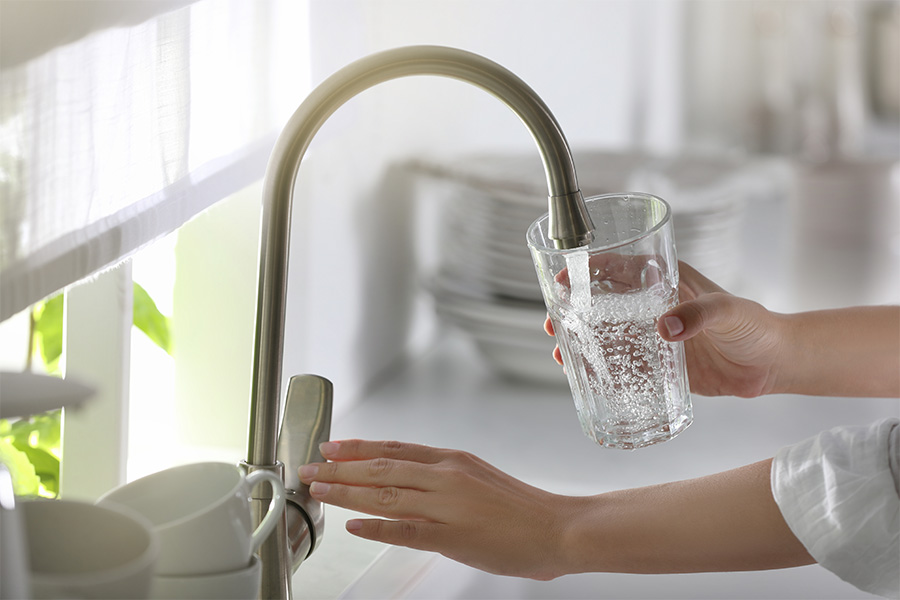Water Quality
-

C 858-13
Mercury in Your Water
Mercury in your drinking water poses a threat to your health. The U.S. Environmental Protection Agency (EPA) has set the current standard for mercury in drinking water at 2 parts per billion (ppb). The amount of mercury in public water systems is regulated according to EPA standards. If your water comes from a public system, it is routinely tested to ensure safe mercury levels. However, if you are concerned about mercury levels in your municipal water supply, you should request a consumer confidence report from your water provider or visit EPA’s site at www.epa.gov/ccr. Unlike users of public water systems, those who use private water supplies (such as wells, springs, and cisterns) are responsible for ensuring the quality of their own drinking water. Since private systems are more susceptible to mercury than public water systems, private well owners should take steps to guard their health. Measures include routine testing and wellhead maintenance and protection.
Gary Hawkins, Pamela Turner, and Uttam Saha
|
-

Municipal water systems are required by law to be monitored for many contaminants found in pesticides, solvents, and petroleum products. However, if your water comes from a private well or from a system that serves fewer than 25 people or has fewer than 15 connections, it is not regulated under these laws. The safety of water from these sources is the responsibility of the owners. If you suspect that your water supply may be contaminated, be sure to have your water tested. Contact your county Extension agent for more information. A home water treatment system can help to protect you from certain contaminants in your water supply.
Gary Hawkins, Pamela Turner, and Uttam Saha
|
-

About 95 percent of Georgia’s rural residents depend on groundwater to supply their drinking water and farm needs. Wells are designed to provide clean water. If improperly constructed and maintained, however, they can allow bacteria, nitrates, pesticides, or petroleum products to contaminate ground water. These contaminates can put family and livestock health at risk. This assessment allows you to evaluate the environmental soundness of your farm and operational practices relating to the condition of your drinking water well.
Gary Hawkins, Pamela Turner, Uttam Saha, and Laurel Dunn
|
-

C 858-12
Arsenic in Your Water
Arsenic in your drinking water poses a threat to your health. Since private systems are more susceptible to arsenic than public water systems, private well owners should take steps to guard their health. Measures include routine water supply testing and wellhead maintenance and protection.
David Kissel, Uttam Saha, and Leticia Sonon
|
-

This publication explains how to identify and remove hydrogen sulfide and sulfate from household water.
David Kissel, Pamela Turner, Uttam Saha, Jason Mowrer, and Leticia Sonon
|
-

C 858-11
Iron and Manganese
Elevated levels of iron (Fe) and manganese (Mn) are two of the most common water quality problems in Georgia’s groundwater. This circular addresses problems associated with high levels of these two elements, levels considered to be a problem, and treatment options to remove the iron or manganese.
Pamela Turner, Uttam Saha, William Smith, Jason Mowrer, and Leticia Sonon
|
-

C 858-3
Home Water Quality and Treatment
The quality of your water supply can have both an immediate and a prolonged effect on the health of your household. Many Americans, especially those dependent upon well water, assume that their water is safe and healthy. Unfortunately, this is not always the case. This publication contains basic information about home water quality and treatment.
David Kissel, Pamela Turner, Uttam Saha, and Leticia Sonon
|
-

C 858-8
Hydrogen Sulfide and Sulfate
This publication describes hydrogen sulfide and sulfate and its effects on household water quality.
David Kissel, Pamela Turner, Uttam Saha, Jason Mowrer, and Leticia Sonon
|
-

C 858-5
Nitrate and Nitrite in Water
Private well owners are responsible for the safety of their drinking water. Maintaining a healthy well requires routine testing for possible contaminants, including nitrate and nitrite. To assist in water safety, the EPA has set standards for nitrate levels in public drinking water systems. Although private well owners are not required to meet these standards, they do serve as a reference for safe drinking water. The EPA Maximum Contaminant Level (MCL) nitrate is: 10 ppm (parts per million) or mg/L (milligrams per liter) nitrate-nitrogen or, if expressed as nitrate, 45 ppm. For nitrite, the MCL is: 1 ppm or mg/L nitrite-nitrogen or, 3.28 ppm if expressed as nitrite. Nitrite is not stable in water and rapidly transforms to nitrate fairly easy. Its presence is an indicator of high concentrations of either nitrate or ammonia.
Gary Hawkins, Pamela Turner, and Uttam Saha
|